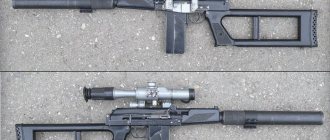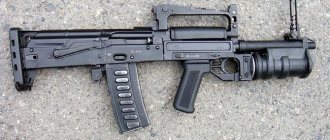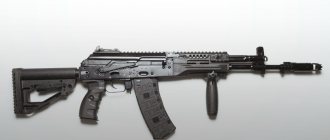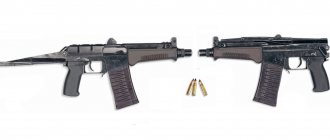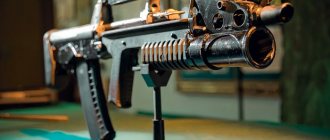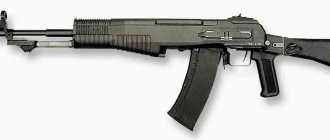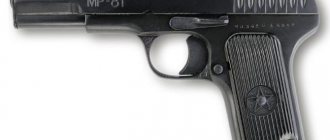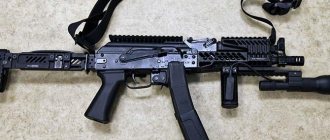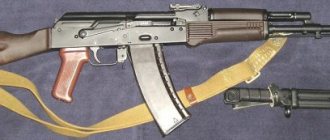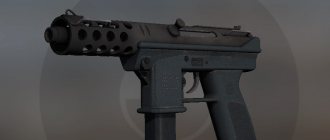ASH-12 assault rifle cartridge caliber 12.7 mm. Device. Rate of fire
Assault machine gun ASH-12. The machine gun is equipped with a magazine for 20 rounds
ASh-12 - Russian large-caliber assault rifle is the basis of the “assault machine gun complex” under the designation SHAK-12, consisting of weapons and subsonic large-caliber 12.7 mm cartridges specially designed for this complex, which use a 55 mm long sleeve from SC cartridges -130 for the VSSK “Vykhlop” rifle and new bullets of shorter length.
The SHAK-12 complex was developed by order of the Russian FSB as a highly effective close-combat “assault” weapon for special forces. The most striking distinctive feature of this model is, first of all, the large-caliber 12.7x55 mm cartridge used in it, which provides a high stopping effect of the bullet while reducing the likelihood of hitting third parties due to the rapid loss of its energy as the firing distance increases.
The first version of the ASh-12 was shown to the public in 2011. Currently, this weapon is mentioned in various sources both under the designation ASh-12 and under the designation SHAK-12, although it is the same product included in the SHAK-12 complex. The weapon was designed by designers from TsKIB SOO (“Central Design Research Bureau of Sports and Hunting Weapons”), a branch of the Tula JSC KBP (“Instrument Engineering Design Bureau named after Academician A.G. Shipunov”).
Assault machine gun ASH-12. The machine gun is equipped with a 10-round magazine and a “tactical” silencer
The 12.7×55 mm cartridge was developed for the ASh-12 at TsKIB SOO on the basis of the cylindrical sleeve of the subsonic rifle cartridge 12.7×55 mm STs-130, which they also developed for the VSSK “Vykhlop” silent sniper rifle and is available in several variants of equipment with different types of bullets - light, heavy, armor-piercing, and there is also a two-bullet version with a tandem arrangement of bullets.
The light bullet of the PS-12A cartridge has a hollow aluminum core exposed in the nose, a bimetallic jacket and a mass of about 7 grams. The muzzle velocity of such a bullet exceeds the speed of sound, however, the combination of a low bullet mass with a large caliber leads to the fact that such a bullet quickly loses speed and energy as the firing distance increases. The effective firing range of such a bullet does not exceed 100 meters, while the bullet of this cartridge has a high stopping effect at short distances.
The heavy bullet of the PS-12 cartridge with a subsonic muzzle velocity is intended primarily for use in combination with a silencer when the situation requires it. The armor-piercing bullets of the PS-12B cartridge are capable of penetrating most body armor and are even dangerous for lightly armored vehicles. A two-bullet (duplex) cartridge with a tandem arrangement of bullets is designated PD-12. The advisability of using such a cartridge in this type of weapon is highly controversial.
According to the developers' plans, thanks to a family of ammunition for various purposes, the ASh-12 automatic carbine should be capable of performing a wide range of tasks to neutralize the enemy under various conditions. But this is only in theory. So far, this model and its cartridges do not have the most significant indicator of combat effectiveness - experience in practical combat use.
In Western countries, there are similar systems of assault weapons chambered for large-caliber cartridges, such as .50 Beowulf and .458 SOCOM, with a bullet weight of about 20 grams. 12.7mm cartridges with hollow-point and jacket bullets are used in various variants of AR-15/M16 rifles and Colt M4-type carbines. Carbines chambered for the above-mentioned large-caliber cartridges have a maximum effective firing range of up to 200 meters.
The .50 Beowulf cartridge was developed primarily from combat experience gained by US Army soldiers and private security agents in Iraq. Patrols not accompanied by heavy armor require weapons that can quickly neutralize an ambush or pursuit, as well as terrorist vehicles attacking checkpoints, which require the appropriate weapons. It must be quite compact and at the same time have the highest possible fire efficiency, both against enemy personnel and vehicles.
For example, the .50 Beowulf carbine works great when you need to quickly stop a vehicle, instantly destroying the engine and hitting the enemy inside, unlike the standard 5.56x45 caliber used in M4 carbines. Small-caliber high-velocity bullets, for all their advantages, have one rather significant drawback - the stopping power of the bullet is not high enough, which is so necessary in close combat. The 50-caliber carbine allows you to quickly neutralize an attacking enemy with the first hit. Cartridges such as .50 Beowulf, .458 SOCOM and .450 Bushmaster in the USA have a certain popularity in the civilian weapons market.
ASH-12 (early version)
The large-caliber automatic carbine ASh-12 is built according to the bullpup design. The receiver is made of stamped steel, and the forend, stock and pistol grip are made of impact-resistant plastic. The ASh-12 uses automation using recoil energy with a short barrel stroke. The barrel is locked by turning the bolt. The bolt handle is folded upward and is located on the right side of the weapon.
The ASh-12 automatic carbine is fed with cartridges from detachable double-row box magazines with a capacity of 10 and 20 rounds. The fire mode selector and fuse are made in the form of separate levers. The fire mode selector lever is located at the rear of the weapon, behind the magazine. The safety lever is located above the pistol grip fire control.
To reduce recoil when firing, the ASh-12 is equipped with a two-chamber muzzle brake-compensator and a rubber butt pad. Instead of a DTK, a muffler can be installed on the muzzle of the barrel. There is an option with an under-barrel grenade launcher. The window for ejecting spent cartridges is protected from dirt by a hinged lid, similar to the American AR-15/M16 rifles.
Chief designer of TsKIB SOO for small arms and cannon weapons Viktor Zelenko demonstrates the ASh-12 assault rifle chambered for 12.7x55 mm
The carrying handle is equipped with a Picatinny rail for mounting various collimator and optical sights. The handle itself is attached to the weapon using the same type of fastener. There is also a Picatinny rail at the lower front of the weapon, which allows you to attach various front handles, a bipod or a flashlight to it. In addition, there are also side bars.
The ASh-12 sights are placed on the carrying handle, which has additional Picatinny rails on the sides. In the ASh-12, the front sight on a folding base has been moved to the front part of the receiver in order to increase the length of the aiming line and, accordingly, increase shooting accuracy. The rear sight is aperture, which gives an advantage over open sights in terms of speed and accuracy of aiming and ease of aiming in low light conditions.
According to unverified information, the first deliveries of these weapons to the customer were made at the end of 2011.
Cartridges 12.7x55 mm. From left to right - with a light bullet, two-bullet, with a heavy bullet, with an armor-piercing bullet.
12.7x55 cartridge case (right) compared to .499 LWR, .50 Bushmaster and 7.62x39 cartridges
Machine guns, assault rifles
The term “ assault rifle ,” which came into Russian weapons terminology as a carbon copy of the German term Sturmgewehr and the English term Assault rifle , is distinguished by the fact that, despite its wide popularity, it does not have a single clear definition. It is usually believed that the author of this term is Adolf Hitler, who in 1944, for propaganda reasons, called an automatic carbine chambered for an intermediate cartridge (a rifle cartridge of reduced power) an “assault rifle.” However, both the basic concept and the term "assault rifle" are actually much older, dating back to the First World War.
For the first time, somewhat known to the author of these lines, the term “assault phase rifle” was used by the American designer Isaac Lewis, creator of the machine gun of the same name, in relation to a line of experimental automatic rifles created in 1918-20 for standard American rifle cartridge .30 M1906 (.30-06, 7.62x63mm). These automatic rifles were created under the same "fire on the move" concept as the Browning BAR M1918 automatic rifle. The authors of this concept are considered to be the French, who proposed arming the infantry with automatic rifles, suitable for firing from the shoulder or from the waist, on the move or from short stops. The purpose of these automatic rifles was to support infantry armed with conventional repeating rifles directly during an attack on enemy positions. The first production model of a weapon of this class can be considered the Shosh submachine gun of the 1915 model (Fusil Mitrailleur CSRG Mle.1915). Soon after it, the Russian automatic rifle of the Fedorov system of the 1916 model appeared, later called the “automatic”. And finally, in 1918, the already mentioned M1918 Browning automatic rifles appeared.
Browning automatic rifle BAR M1918 as an “assault weapon”
The automatic “assault phase rifle” of the American Isaac Lewis unsuccessfully tried to compete with the Browning automatic rifle BAR M1918
All of the above examples of automatic “assault” rifles had one common drawback - they used standard rifle cartridges of that period, which had frankly excessive energy and firing range for “assault” use, impressive recoil, and, as a result, significant dimensions and weight of cartridges and weapons under it. This was explained by the fact that rifle cartridges of that period were created in the late 19th and early 20th centuries, when salvo fire from rifles at long ranges was a normal and generally accepted method of firing by infantry units. As a result, the lethal range of rifle bullets of that period reached two kilometers or even more, whereas in a real battle an ordinary soldier can hardly expect to see an enemy soldier at a distance of more than 300-400 meters, not to mention hitting him with how many any significant probability. At the same time, no one denied the usefulness and importance of maneuverable automatic fire for suppressing enemy resistance, both in attack and defense.
An obvious solution to the problem raised could be the development of new cartridges of reduced power, allowing them to solve the problem of defeating enemy soldiers at ranges of up to 300-500 meters instead of a kilometer or more. The creation of such cartridges promised a significant gain in the mass of cartridges and weapons for it, in reducing recoil when firing, in saving materials and gunpowder, and in increasing the carryable ammunition of cartridges. Moreover, there was real combat experience in using such weapons - in 1917-18, the French infantry successfully used American Winchester 1907 carbines chambered for .351 WSL (9x35SR), equipped with increased-capacity magazines and converted for burst fire. These carbines were noticeably shorter, more convenient and maneuverable than standard rifles of that time, provided impressive firepower at ranges of up to 200-300 meters, and, in fact, became the harbingers of a new class of weapons - automatic carbines chambered for rifle cartridges of reduced power, otherwise called “intermediate” (between pistol and conventional rifle).
Winchester M1907 carbine in the “assault” version and the .351 WSL cartridge for it
Taking into account all of the above, already in 1918 in France, on the basis of the .351WSL hunting cartridge, a special army cartridge 8x35SR was created, equipped with a pointed bullet from the 8mm Lebel cartridge. Designer Ribeyrolles created an experimental automatic carbine for this cartridge. In the same year, a similar cartridge was created in the USA by the Winchester company. Taking the cartridge case of the same .351WSL as a basis, the Americans equipped it with a pointed 9mm caliber bullet, calling the new cartridge .345WMR (Winchester Machine Rifle). A very original automatic carbine of the Burton system (Burton-Winchester Machine Rifle) was also developed for this cartridge. In the early twenties, similar cartridges and self-loading or automatic carbines for them were created in Switzerland and Italy, in the thirties - in Denmark and Germany. And none of these samples ever entered service.
| Ribeirol automatic carbine chambered for 8x35SR cartridge | Automatic Burton system carbine chambered for .345WMR |
Let's try to figure out why such a promising weapon did not find understanding with the customer until 1942. Of course, we cannot know all the exact reasons, but no one is stopping us from making reasonable assumptions. So. 1) High-ranking military officials are conservative by nature, and do not like to risk their careers in the name of systems whose usefulness is not obvious. And most of the high-ranking military of that period were raised and trained in the era of repeating rifles with a magazine cut-off, volley shooting and bayonet attacks in close formation. The idea of arming ordinary infantrymen en masse with rapid-firing automatic weapons was largely alien to most of these military leaders. 2) Despite the obvious savings in materials and costs for the production and delivery of each cartridge, the significantly increased consumption of cartridges in automatic weapons compared to repeating rifles still meant an increase in the load on both production and logistics. 3) By the end of the First World War, the machine gun had become an integral element of infantry weapons. The use of significantly weakened intermediate cartridges in machine guns, especially easel ones, meant a sharp loss in the effectiveness of their fire on all types of targets, which, in turn, meant the need to introduce a new “weakened” cartridge in parallel with existing rifle cartridges (and not instead of them), which also complicated logistics 4) Until the end of the thirties, typical targets for individual infantry small arms fire included not only enemy soldiers, but also targets such as horses (cavalry in many countries was still considered an important branch of the military), as well as armored vehicles and low-flying airplanes. The use of weakened “intermediate” cartridges could sharply reduce the infantry’s ability to combat these targets, which was considered unacceptable
Of course, there were other reasons, and, as a result, in the interwar period, in most countries of the world, self-loading rifles chambered for “traditional” rifle cartridges were considered as promising individual infantry weapons. Attempts to adopt reduced-power cartridges for self-loading rifles (for example, the American experience with .276 Pedersen / 7×51 cartridges) or to create automatic rifles chambered for a standard cartridge (Soviet ABC-36 under 7.62x54R, German FG-42) were unsuccessful. As a result, by the beginning of the Second World War, most of the infantry of the countries participating in the conflict were still armed with repeating rifles or self-loading rifles.
The Second World War, with its increased (compared to the First World War) mechanization and rapidly developing operations, clearly demonstrated that in combat clashes of large masses of infantry, the main importance is not the accuracy of fire or the power of ammunition, but the total number of shots fired towards the enemy. According to data collected after the war, on average, one killed soldier fired from several thousand to several tens of thousands of shots. Moreover, cavalry quickly disappeared from the scene, and the development of armored vehicles and aviation made them less vulnerable to even the most powerful rifle cartridges. It must be said that the understanding of this fact came to German military experts back in the mid-thirties, when, against the background of general militarization, the first work began on the creation of intermediate cartridges and weapons for them. However, such work began in earnest only in 1940, when the Wehrmacht Armaments Directorate (Heereswaffenamt, or HWaA for short) approved the new 7.92x33 cartridge developed by Polte as promising. This cartridge was inferior in ballistic characteristics to a number of other experimental cartridges of about 7mm caliber, and was chosen mainly for the opportunity to use in the production of cartridge components (cases, bullets) and barrels for it existing equipment engaged in the production of cartridges and barrels for the 7.92x57 Mauser rifle cartridge. In 1940, HWaA entered into contracts for the development of "automatic carbines" (Mashinenkarabiner) with the companies Haenel and Walther, and in 1942 these automatic carbines were already sent to the front for military trials. In general, the new “MashinenKarabiniers” received positive reviews from the troops, and their speedy introduction into service could be hampered by two factors - the need for design modifications at the request of the troops, as well as Hitler’s categorical order banning the introduction of new weapon systems. However, the military found a way to circumvent Hitler’s order by simply renaming the “automatic carbine” into a “submachine gun” (Maschinenpistole), and launching a modified Haenel model into series in 1943 under the symbol MP.43. Military operation of the new “submachine guns” chambered for an intermediate cartridge showed the correctness of the adopted concept, and as a result, in 1944, Hitler nevertheless approved the adoption and launch of mass production of the new system, simultaneously awarding it the new name Sturmgewehr, that is, “assault rifle” " This name had a purely propaganda meaning, and, as happens with successful advertising slogans, it stuck regardless of the fact that in historical reality these same “Sturmgewehrs” were used mainly in defense, against actively advancing units and formations of the allies in the anti-Hitler coalition.
German soldier with automatic carbine MKb.42(H)
Since 1939, the development of a carbine for a specially created cartridge of reduced power was carried out in the USA. True, the tactical concept of the American “light rifle” program (.30 cal Light Rifle) was diametrically opposed to the concept of an “assault” rifle - the new carbine was created as a means of self-defense for military personnel, instead of ineffective pistols. The .30 M1 Carbine cartridge (7.62×33) created for the new carbine, by modern standards, looks underpowered compared to other intermediate cartridges (E0 = 1300 J), but its muzzle energy is approximately twice that of typical pistol cartridges. Initially, these carbines were supposed to have the ability to fire bursts and have high-capacity magazines, but during the competition the Army abandoned these requirements, and the M1 carbine, developed by Winchester, went into service in a self-loading version. Nevertheless, this carbine turned out to be extremely convenient as an “assault” weapon, especially in battles in built-up areas or in forests and jungles, where firing ranges are short. As a result, the M1 carbine became one of the most popular examples of self-loading weapons of the 2nd World War, and in 1944, on its basis, a full-fledged automatic M2 carbine was created, which was mass-produced.
The main lessons that were learned from World War II in relation to individual infantry weapons were that in mass battles, and even more so on the scale of entire campaigns, individual shooting skills and design features of small arms play a relatively small role. In fact, for every enemy soldier killed by small arms, up to several tens of thousands of bullets were fired, while the main effective fire distances from individual weapons rarely exceeded 300 meters. A reasonable conclusion from these lessons was that the determining factor in the effectiveness of infantry fire was the total number of bullets fired at the enemy during each battle. In this context, the idea of a lightweight automatic weapon chambered for a lighter and less powerful intermediate cartridge became extremely attractive (submachine guns had an insufficient effective firing range, not exceeding 200 meters). As a result, work on such ammunition and weapons for them began in the USSR, Great Britain, France, and Belgium. At the same time, in the United States, army experts still stubbornly believed in the ability of a well-trained fighter to conduct targeted fire with single shots at a distance of up to 1000 yards (910 meters). While not rejecting the value of automatic fire, the Americans, however, did not want to sacrifice firing range, and in the first half of the fifties they created the T61 cartridge, now known as 7.62x51 NATO. This cartridge was somewhat shorter and lighter than its predecessor, the .30-06 (7.62x63), but its ballistic characteristics, including recoil impulse, were maintained at the same level as the older cartridge. Due to the leading position of the United States in the NATO bloc, these works buried very promising Anglo-Belgian developments on the 7x43 intermediate cartridge and weapons for it. In subsequent decades, the NATO bloc was armed with long-range, but relatively heavy and long rifles chambered for 7.62x51, the automatic fire of which was so ineffective that it was either abandoned completely (as the British did with the L1A1 SLR rifle) or blocked by removing the translator fire mode (as the Americans did with the M14).
In the USSR, by the beginning of the fifties, the concept of an intermediate cartridge had found full implementation in the form of a whole family of weapons chambered for the 7.62x39 cartridge of the 1943 model, including the Kalashnikov AK assault rifle, the Simonov SKS self-loading carbine and the Degtyarev RPD light machine gun.
Kalashnikov assault rifles have proven themselves to be very successful in many conflicts, including the Vietnam War
And here we should interrupt the historical excursion for a while and return to issues of terminology. As we have already seen, the term “assault rifle” was mainly propaganda; from the point of view of weapons technology, the Stg.44 and its followers would be much more correctly called automatic carbines, as was done with its predecessors - Mkb.42(W) and Mkb.42(H). Moreover, in the fifties, the term Sturmgewehr was officially used to designate two automatic rifles chambered for “full-fledged” powerful rifle cartridges, namely the Austrian Stg.58 (FN FAL, 7.62×51) and the Swiss Stgw.57 (SIG 510, 7.5×55 ). What's particularly interesting in this context is that both countries are neutral and, logically, their "assault rifles" are primarily defensive weapons rather than offensive. Further, in most countries of the world, military rifles are officially designated simply “rifle” (for example, “Rifle, M14,” “Gewehr G3,” etc.), sometimes with the indication “self-loading” or “automatic.” It is understood that this rifle can be used in any way - defensive, offensive, ceremonial, and is in no way determined by its name.
In domestic terminology, in relation to automatic weapons chambered for an intermediate cartridge, the term “Automatic” is officially used, which, according to GOST “Small arms. Terms and definitions" and stands for "automatic carbine". Again, this term does not imply any specific type of cartridge, nor the defensive or offensive purpose of the weapon. Moreover, historically this term was quite correctly applied to Fedorov’s automatic rifle (machine gun) chambered for the “full-fledged” rifle cartridge 6.5 Arisaka, and to submachine guns from the times of the Great Patriotic War (for example, PPSh-41 was officially called “machine gun model 1941”) . Summarizing the above, we can say that the term “assault rifle” itself does not carry a deep technical or tactical meaning, and has taken root mainly because of its sonority. The term “automatic” is quite correct and defines a subset of automatic rifles that have reduced size and weight (i.e. automatic carbines). The type of cartridge used here can conditionally determine the “generation” of manual automatic weapons, i.e. weapons chambered for rifle cartridges can be classified as the first generation, weapons chambered for intermediate standard caliber cartridges (7.62-8 mm) - to the second. At the same time, we must not forget that this division is purely arbitrary and is not directly related to the time of birth of a particular sample.
Having decided on the terminology, let’s continue our brief historical excursion into slot machines. The failure of the American attempt to create a universal infantry automatic rifle chambered for the powerful 7.62x51 NATO cartridge forced them to rush to the other extreme. Taking as a basis the conclusions that had become completely obvious about the severely limited capabilities of the shooter to detect and hit targets at ranges over 300 meters, the Americans began work to increase the likelihood of hitting a target at short ranges. To achieve this, a variety of concepts were tested, including salvo firing with conventional and arrow-shaped bullets, firing in bursts of limited length at a high rate, multi-bullet cartridges, and the like. The practical result of this work was the creation at the end of the fifties of a small-caliber, low-impulse cartridge of 0.22 inches (5.56mm) caliber, which provided a low mass of ammunition, low recoil, and good trajectory flatness at short and medium ranges. The lethal effect of such cartridges compared to conventional rifle cartridges has been somewhat questioned, but as the Americans themselves say: “it’s better to hit the enemy with a small bullet than to miss with a big one.” And the new low-pulse cartridges provided a noticeably higher probability of hitting a target at typical firing ranges compared to “traditional” rifle cartridges, especially when firing in short bursts. The result of this work is well known - in the sixties, the M16 assault rifle (automatic rifle) chambered for the small-caliber, low-impulse cartridge 5.56x45 was adopted in the United States. By the beginning of the eighties, almost all the largest armed forces of the world, both on the other side of the Iron Curtain and on this, began to actively switch to low-pulse cartridges. The only notable exception at that time was Germany, where the Bundeswehr, with tenacity worthy of better use, waited for the G11 micro-caliber caseless system to be put into service. For a number of reasons, mostly objective, this never happened, and from the mid-nineties the Bundeswehr began to receive “third generation” HK G36 assault rifles chambered for the small-caliber, low-pulse NATO cartridge 5.56x45.
The career of the M16 automatic rifle began in Vietnam
In recent years, in the world (primarily in the USA), there has been a tendency towards a slight increase in the caliber of infantry weapons to approximately 6.5-6.8 mm, in order to increase the effective firing range and lethality in comparison with 5.56 mm cartridges, without overweighting the weapon and trying keep recoil when shooting within reasonable limits. This concept is nothing new. A caliber in the range of 6-7 mm has been proposed as optimal specifically for individual infantry weapons since the beginning of the 20th century - just remember the works of the Russian gunsmith Fedorov. At the same time, modern assault rifles and commercial self-loading rifles, which a number of companies are trying to push into service with the US Army, essentially differ very little from, say, the Italian Cei-Rigotti automatic rifle of the 1905 model or from the Russian Fedorov assault rifle of the 1916 model. Of course, modern materials and technologies have made it possible to make weapons somewhat more convenient, much more reliable and much easier to mass produce, but from the point of view of the main task of weapons - hitting a target, the achievements of the last 100 years are extremely insignificant. And there is a simple explanation for this: the effectiveness of hitting a target is determined primarily by the ammunition used, and in terms of ballistic characteristics, the differences between the modern 6.8x43 Remington SPC cartridge and, for example, the 6.5x51SR Arisaka cartridge used in the Fedorov assault rifle are very small. Therefore, until the emergence of fundamentally new types of ammunition or even methods for hitting a target, the main direction for improving individual infantry weapons (and all other types of military small arms) can only be the development of sighting devices that increase the likelihood of hitting a target by reducing the shooter’s aiming errors, which are the main the cause of mistakes.
A US Navy SEAL fighter with a SCAR-H Mk.17 automatic rifle of 7.62x51 caliber. Interest in such seemingly outdated weapons is explained both by the increase in the range of fire contacts in recent conflicts and by the development of personal protective equipment (body armor). The main fire mode for such rifles is single shots.
Photo ASh-12
Similar
AK-47 assault rifle cartridge caliber 7.62 mm. Device. Rate of fire
AK-74 assault rifle cartridge caliber 5.45 mm. Device. Rate of fire
Dragunov SVD sniper rifle caliber 7.62 mm. Device
AKS-74U assault rifle cartridge caliber 5.45 mm. Device. Weight
Mauser K96 pistol cartridge caliber 7.63 and 9 mm. Device
Pistol Walter PP / PPK cartridge caliber 7.65 and 9 mm. Device
Pistol Yarygin PYa Grach cartridge caliber 9 mm. Device
DShK machine gun cartridge caliber 12.7 mm. Device. Rate of fire
Luger pistol R.08 Parabellum cartridge caliber 9 mm. Device
Pistol PM cartridge caliber 9 mm. Rate of fire. Dimensions. Bullet speed. Sighting range
Self-loading shotgun Saiga-12 cartridge, caliber. Device
Maxim machine gun cartridge caliber 7.62 mm. Device. Weight
PPSh-41 Shpagina submachine gun cartridge caliber 7.62 mm
APS Stechkin pistol cartridge caliber 9 mm. Device
Nagan system revolver cartridge caliber 7.62 mm. Device
Kalashnikov PK machine gun and PKM cartridge caliber 7.62 mm. Device
Simonov carbine SKS-45 cartridge caliber 7.62 mm. Device
Rifles and carbines Mauser 98 caliber 7.92 mm. Device
PPS-42 and PPS-43 Sudaev submachine gun cartridge caliber 7.62 mm
Pistol Walter P38 cartridge caliber 9 mm. Device
MP-40 German submachine gun cartridge caliber 9 mm. Device
VSS Vintorez sniper rifle caliber 9 mm. Device
Submachine gun PP-91 Kedr cartridge 9 mm caliber. Device
Light machine gun RPK-74 cartridge caliber 5.45 mm. Device
Pistol Glock 17 cartridge caliber 9 mm. Device
Makarych, Izh-79-9T, MR-79-9TM, MP-80-13T traumatic pistol
AK-12 assault rifle cartridge caliber 5.45 mm. Device. Weight
Mosin rifles and carbines Three-line caliber 7.62 mm
PMM Makarov pistol modernized 12 rounds. Device
Revolver Colt Single Action Army (SAA) Peacemaker. Device
Machine gun PKP Pecheneg cartridge caliber 7.62 mm. Device
Sniper rifle VSSK Exhaust caliber 12.7 mm. Device
Beretta pistol 92 cartridge caliber 9 mm. Device
TT - Tokarev pistol cartridge caliber 7.62 mm. Device
Submachine gun PP-19 Bison cartridge caliber 9 and 7.62 mm. Device
Sniper rifle SV-98 caliber 7.62 mm. Device
Vladimirov KPV machine gun cartridge caliber 14.5 mm. Device
ASH-12 assault rifle cartridge caliber 12.7 mm. Device. Rate of fire
PSM pistol cartridge caliber 5.45 mm. Device
Pistol Colt M1911A1 cartridge caliber 45. Device
Smith-Wesson revolver Russian cartridge, caliber 10.67 mm. Device
Degtyarev DP-27 light machine gun, 7.62 mm caliber cartridge. Device
Shotgun Mossberg 500 Cartridge. Dimensions. Rate of fire. Sighting range
Thompson submachine gun cartridge caliber 11.43 mm. Device
Pistol USP Heckler und Koch cartridge, caliber. Device
Hunting carbine OSK-88 (SVT-40) caliber 7.62 mm. Device
AS Val silent automatic cartridge caliber 9 mm. Device
Submachine gun PP-19-01 Vityaz cartridge 9 mm caliber. Device
Machine gun Kord cartridge caliber 12.7 mm. Device. Weight. Sighting range
Osa - traumatic pistol cartridge, caliber. Device
AK-9 assault rifle cartridge caliber 9 mm. Device. Rate of fire
Degtyarev RPD light machine gun, 7.62 mm caliber cartridge. Device
Automatic OTs-14 Groza cartridge caliber 9 mm and 7.62 mm. Device
Czech pistol CZ-75 (modifications). Device
Browning pistol 1903 cartridge caliber 9 mm. Device
Sniper rifle OSV-96 caliber 12.7 mm. Device
FN P90 submachine gun cartridge caliber 5.7 mm. Device
Submachine gun OTs-02 Cypress cartridge caliber 9 mm. Device
Sniper rifle ASVK Kord caliber 12.7 mm. Device
Automatic AEK-971 Cartridge. Caliber. Device. Rate of fire
Steyr AUG assault rifle (A1, A2, A3) cartridge caliber 5.56 mm
AK series 100 assault rifles. Modifications. Device. Weight. Dimensions
Uzi submachine gun. Cartridge. Caliber. Rate of fire
Pistol SR1M Gyurza cartridge caliber 9 mm. Device
Pistol GSh-18 cartridge caliber 9 mm. Device
SVDK sniper rifle caliber 9.3 mm. Device
Automatic SR-3M Whirlwind cartridge caliber 9 mm. Device
Machine gun NSV-12.7 Utes cartridge, cal. Device. Weight
Kalashnikov RPK light machine gun cartridge caliber 7.62 mm. Device
Sniper rifle VSK-94 caliber 9 mm. Device
Vostok-1 (Jorge-3M) 9mm caliber traumatic pistol. Device
Degtyarev PPD submachine gun cartridge caliber 7.62 mm
English sniper rifle L96A1 cartridge, caliber
M1 Garand rifle cartridge caliber 7.62 mm. Device
Desert Eagle pistol. Device
Smith-Wesson revolver (modifications). Device
Automatic rifle HK G36 (E, K, C, KE) cartridge caliber 5.56 mm
Pistol P-96 cartridge caliber 9 mm. Device. Rate of fire
Pistol GP35 Browning High Power cartridge, caliber. Device
Assault rifle FN SCAR (L, H) cartridge caliber 5.56 and 7.62 mm
Revolver Lefoshe M1856 cartridge caliber 11 mm. Device
Submachine gun PP-90 cartridge caliber 9 mm. Device
AN-94 Abakan automatic Nikonov cartridge caliber 5.45 mm. Device
Submachine gun PP-2000 cartridge caliber 9 mm. Device
Mauser pistol HSc cartridge caliber 7.65 and 9 mm. Device
M16 automatic rifle cartridge caliber 5.56 mm. Device
Fedorov assault rifle cartridge caliber 6.5 mm. Device. Rate of fire
Pistol Baltiets cartridge caliber 7.62 mm. Device
Strizh pistol cartridge caliber 9 mm. Device. Weight. Sighting range
Browning pistol 1910 cartridge caliber 7.65 and 9 mm
Silent pistol PSS Vul cartridge caliber 7.62 mm. Device
Pistol SIG-Sauer P226 cartridge caliber 9 mm. Device
Pistol OTs-27 Berdysh cartridge caliber 7.62 mm and 9 mm. Device
AK-107 assault rifle cartridge caliber 5.45 mm. Device. Rate of fire
OTs-44 sniper rifle, caliber 12.7 mm. Device
German machine gun MG3 cartridge caliber 7.62 mm. Device
Self-loading shotgun Browning Auto-5 cartridge, caliber. Device
Submachine gun AEK-919K Kashtan cartridge caliber 9 mm. Device
PB pistol silent cartridge 9 mm caliber. Device
Pistol OTs-33 Pernach cartridge caliber 9 mm. Device
Hunting carbine KO-98 cartridge caliber 7.92 mm. Device
TK (Korovin pistol) caliber 6.35 mm. Device. Weight. Dimensions
Underwater assault rifle APS cartridge caliber 5.66 mm. Device
Pistol OTs-21 Malysh cartridge caliber 9 mm. Device
American M60 machine gun, 7.62 mm caliber cartridge. Device
MTs-116M sniper rifle, caliber 7.62 mm. Device
Automatic 9A-91 cartridge caliber 9 mm. Device. Rate of fire
Submachine gun PP-93 cartridge caliber 9 mm. Device
VAG-73 - Gerasimenko pistol. Device. Weight. Dimensions
Cordon-5 is a traumatic pistol. Device. Weight. Dimensions
Goryunov SG-43 heavy machine gun cartridge caliber 7.62 mm. Device
Webley revolver cartridge, caliber. Device. Dimensions. Weight
Machine gun AEK-999 Badger cartridge caliber 7.62 mm. Device
RP-46 machine gun, 7.62 mm caliber cartridge. Device. Rate of fire
Sniper rifle VS-8 cartridge caliber 8.6 mm. Device
Slostin machine gun cartridge caliber 7.62 mm and 14.5 mm. Device
Assault rifle Tavor TAR-21 cartridge caliber 5.56 and 5.45 mm
Submachine gun SR-2 Veresk cartridge caliber 9 mm. Device
Lancaster pistol cartridge caliber 12.1 mm. Device. Rate of fire
Submachine gun PP-90M1 cartridge caliber 9 mm. Device
Underwater pistol SPP-1M. Device. Weight. Dimensions
Traumatic pistol MP-461 Guard. Device. Weight. Dimensions
Lebel rifles and carbines are cartridgeed in 8 mm caliber. Device
Automatic A-91 cartridge caliber 7.62 mm. Device. Rate of fire
M14 automatic rifle cartridge caliber 7.62 mm. Device
Revolver Smith & Wesson Model 10 Military & Police
Automatic rifle FN FAL cartridge caliber 7.62 mm. Device
Submachine gun STEN MK 2. Device. Weight. Dimensions
Traumatic pistol IZH-78-9T Chain mail cartridge caliber 9 mm
Leader-M traumatic pistol 11.43×32T. Device. Weight. Dimensions
Ingram M10 and M11 submachine gun. Device. Weight. Dimensions
Pistol Steyr M9-A1 cartridge caliber 9 mm. Device. Weight
Pistol OTs-23 Dart cartridge caliber 5.45 mm. Device
Berthier rifles and carbines caliber 8 mm. Device
Automatic shotgun USAS-12 cartridge caliber 18.5 mm
Sniper rifle VS-121 caliber 7.62 mm. Device
Traumatic pistol MP-353 cartridge, caliber 11.43 mm
Tiss machine gun cartridge caliber 9 mm. Device. Rate of fire
Traumatic pistol MP-355 cartridge caliber 9 mm. Device
Automatic double-medium ADS cartridge caliber 5.45 mm. Device. Rate of fire
Traumatic pistol MP-81 cartridge caliber 9 mm. Device
Pistols Zastava 70 and 70(k), cartridge caliber 7.65 or 9 mm. Yugoslavia
Sniper rifle GALATZ (Galil) cartridge caliber 7.62 mm
Pistol MP-444 Bagheera cartridge caliber 9 mm. Device
Revolver Colt New Army / Navy. Device. Bullet speed. Sighting range
Type 64 is a Japanese automatic rifle. Device
